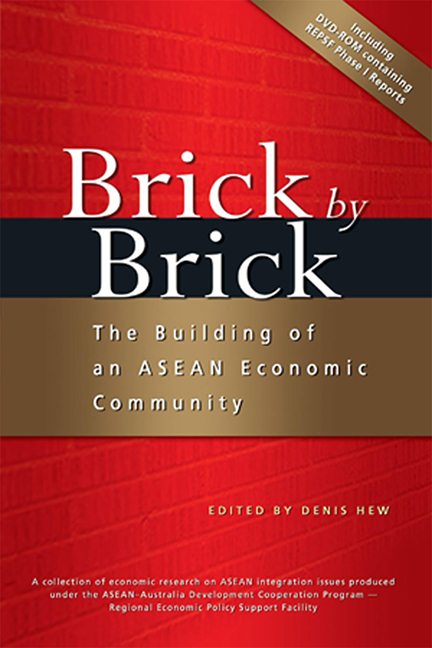Book contents
- Frontmatter
- Contents
- Foreword by Ong Keng Yong
- Foreword by Bruce Davis
- Acknowledgements by Academic Editor
- Acknowledgements by Technical Director REPSF
- The Contributors
- The Regional Economic Policy Support Facility
- 1 Introduction: Brick by Brick — The Building of an ASEAN Economic Community
- 2 What is a Single Market? An Application to the Case of ASEAN
- 3 The Challenge of Economic Integration for Transitional Economies of Southeast Asia
- 4 A Review of Regional Tariffs and Trade in the ASEAN Priority Goods Sectors
- 5 Non-tariff Barriers to Trade in the ASEAN Priority Goods Sectors
- 6 An Assessment of ASEAN's Priority Sectors for Fast-track Integration
- 7 ASEAN Tax Regimes: Impediment or Pathway to Greater Integration
- 8 An Overview of the Foreign Direct Investment Jurisprudence
- 9 ASEAN's FTA Negotiations with Dialogue Partners:Identifying Strengths and Weaknesses in Business Opportunities
- 10 Conclusion: Towards an ASEAN Economic Community by 2015
- Index
- Contents of Accompanying CD-ROM: AADCP-REPSF Phase I Research Program
10 - Conclusion: Towards an ASEAN Economic Community by 2015
Published online by Cambridge University Press: 21 October 2015
- Frontmatter
- Contents
- Foreword by Ong Keng Yong
- Foreword by Bruce Davis
- Acknowledgements by Academic Editor
- Acknowledgements by Technical Director REPSF
- The Contributors
- The Regional Economic Policy Support Facility
- 1 Introduction: Brick by Brick — The Building of an ASEAN Economic Community
- 2 What is a Single Market? An Application to the Case of ASEAN
- 3 The Challenge of Economic Integration for Transitional Economies of Southeast Asia
- 4 A Review of Regional Tariffs and Trade in the ASEAN Priority Goods Sectors
- 5 Non-tariff Barriers to Trade in the ASEAN Priority Goods Sectors
- 6 An Assessment of ASEAN's Priority Sectors for Fast-track Integration
- 7 ASEAN Tax Regimes: Impediment or Pathway to Greater Integration
- 8 An Overview of the Foreign Direct Investment Jurisprudence
- 9 ASEAN's FTA Negotiations with Dialogue Partners:Identifying Strengths and Weaknesses in Business Opportunities
- 10 Conclusion: Towards an ASEAN Economic Community by 2015
- Index
- Contents of Accompanying CD-ROM: AADCP-REPSF Phase I Research Program
Summary
The vision of an ASEAN Economic Community (AEC) by 2015 is certainly bold and ambitious. Although there are already building blocks in place such as the ASEAN Free Trade Area (AFTA), the ASEAN Investment Area (AIA) and the ASEAN Framework Agreement on Services (AFAS), ASEAN faces a number of daunting challenges in realizing this vision. From the studies presented in the preceding chapters, a number of compelling questions emerge. Among these are:
(i) whether or not the roadmap to achieve the AEC is realistic given the relatively short timeline set to undertake this endeavour;
(ii) whether the progress made in expediting economic integration, particularly of the fast-track integration of the priority sectors, is on track to achieve its targets and objectives;
(iii) whether ASEAN has the institutional framework to support such deeper economic integration; and
(iv) whether ASEAN would be able to successfully address the economic development divide among its member countries.
There is also the nagging question of what is the ultimate end-goal of the AEC — is it a European-style common market or just a free trade area? To be sure, these challenges need to be seriously addressed in the short to medium term. In this concluding chapter, key issues are discussed reflecting the challenges ahead.
Addressing the Stumbling Blocks to Economic Integration
Tackling Barriers to Trade
Although most ASEAN countries have complied with tariff reductions under AFTA, Tongzon (2005) found the utilization of the Comprehensive Effective Preferential Tariffs (CEPT) has been relatively low due to lack of clear and transparent procedures, a lack of mutual trust between preference-receiving country and preference-granting country, low margin of tariff preferences (between CEPT and most-favoured nation rates) and a lack of private sector awareness regarding AFTA concessions. Furthermore, the less developed ASEAN countries may be reluctant to fully implement AFTA given the huge losses in customs revenue due to the implementation of the CEPT (Tongzon and Khan 2005). Intra-ASEAN trade has not increased significantly since the signing of AFTA in 1992 (see Figure 10.1). Studies in this book on the priority sectors have also found that non-tariffs measures (NTMs) continue to persist and impede greater intra-ASEAN trade. Hence, effectively tackling NTMs, particularly those that are barriers to trade, would be crucial if a fully functioning AFTA is to be feasible by 2015.
- Type
- Chapter
- Information
- Brick by BrickThe Building of an ASEAN Economic Community, pp. 209 - 226Publisher: ISEAS–Yusof Ishak InstitutePrint publication year: 2007



